The Apple iPhone 6s and iPhone 6s Plus Review
by Ryan Smith & Joshua Ho on November 2, 2015 8:00 AM EST- Posted in
- Smartphones
- Apple
- Mobile
- SoCs
- iPhone 6s
- iPhone 6s Plus
Battery Life
With any smartphone, battery life is always one of the most important considerations. It probably goes without saying that more battery life is always better. In the case of the iPhone 6s, battery life is especially important to examine because this year Apple has actually made the battery of their phone smaller than before. Normally, it’s almost a given that battery size will be at least constant or increase but in order to accommodate additional components like the Taptic engine the battery has been made smaller. In light of this reversal one might assume that battery life has decreased as a result, but given the move to a FinFET process and other major component improvements it’s hard to say how battery life has increased or decreased. In order to test this properly, we ran the iPhone 6s’ through our suite of battery life tests to try and get an idea for overall battery life. As always, we run all battery life tests with the display set to an average of 200 nits and all possible background tasks disabled.
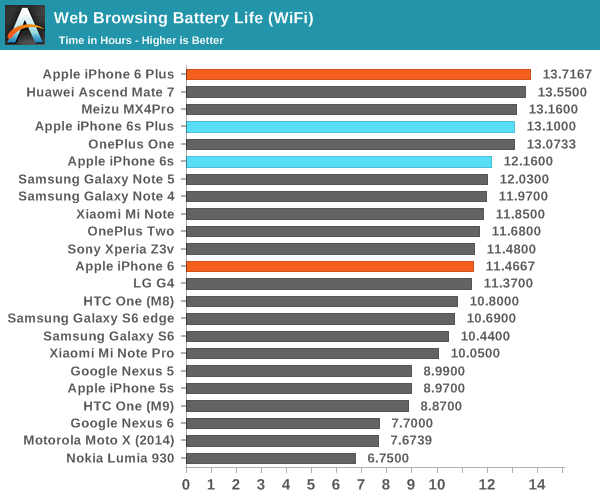
Our first test is WiFi web browsing, and here we see a pretty curious trend. The iPhone 6s Plus appears to regress relative to the iPhone 6 Plus, yet the iPhone 6s solidly beats the iPhone 6. I was pretty confused by this, but it’s likely that we’re seeing these results because the iPhone 6s is going to have larger relative power consumption of the SoC when compared to the display. As the display becomes bigger, the effects of SoC efficiency are just harder to notice, which also explains why it looks like the iPad Air 2 has effectively the same battery life whether you’re running just a blank display or our web browsing test. Both of our review units use a TSMC A9, so I don’t think we can attribute a foundry difference to the odd results that we’re seeing here.
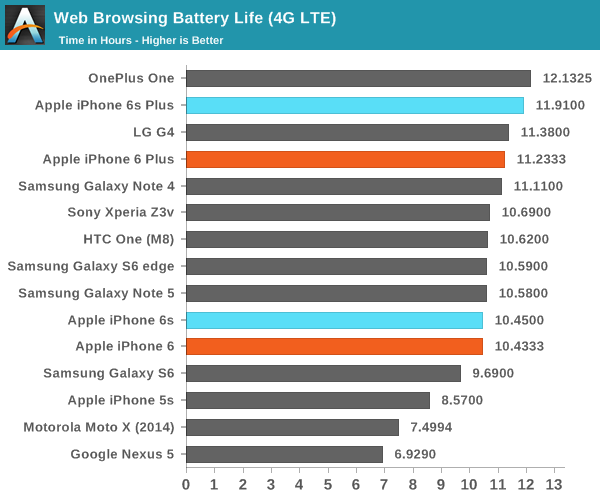
In LTE web browsing, we see a smaller improvement than what we observed in the WiFi test. This might seem strange, but given that the move from a 28nm process to a 20nm process on the modem from iPhone 6 to 6s didn’t come with FinFET it makes sense that the modem will remain a significant power drain. It’s likely that the next big jump in battery life here will come with FinFET process technology on the modem, along with other general modem design improvements.
In order to also look at battery life in more extreme scenarios, we use Basemark OS II and GFXBench to really place a strong stress on the CPU and GPU to see what power draw is like under sustained load. This also allows us to see the extent to which various components of the phone throttle down in response to relatively high sustained loads. However, it’s important to note that the Basemark OS II performance score here isn’t necessarily as accurate as scores from Android devices as the battery score can be calculated with 98 data points instead of 80 as battery score is partially derived from the rate at which the battery percentage decreases. It's also worth noting that in GFXBench there are two data points removed as the low power popup causes an incorrect frame rate to be recorded.
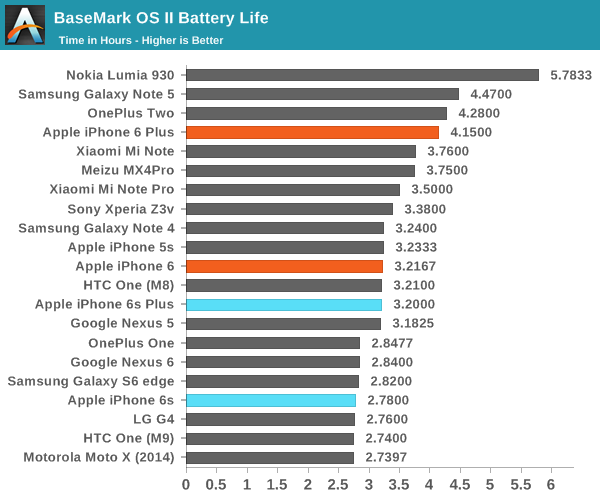
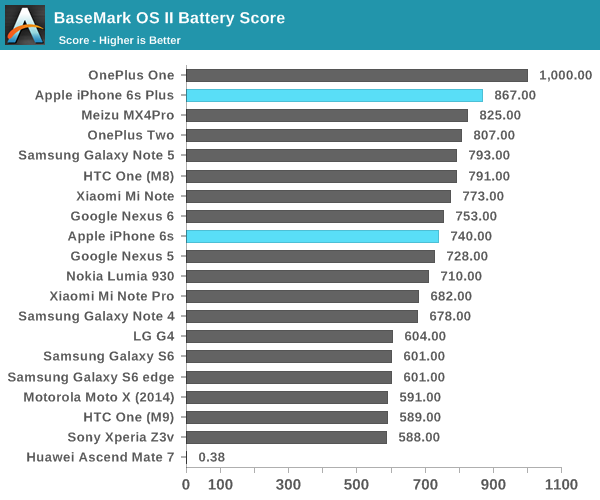
In Basemark OS II, we start off with a pretty shocking result as the iPhone 6s lasts less than three hours in this test, but looking at the battery score it’s pretty clear that the reason why the iPhone 6s doesn't last very long is because it’s running with relatively little throttling throughout the test, so the battery score is high as a result. The same is true of the iPhone 6s Plus, but the larger battery helps it to last a bit longer.
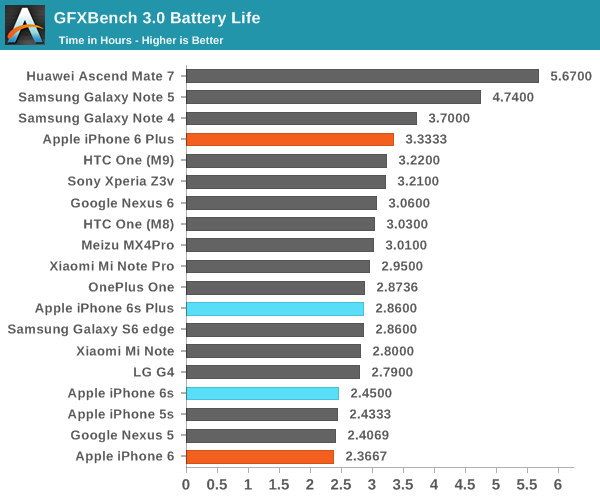
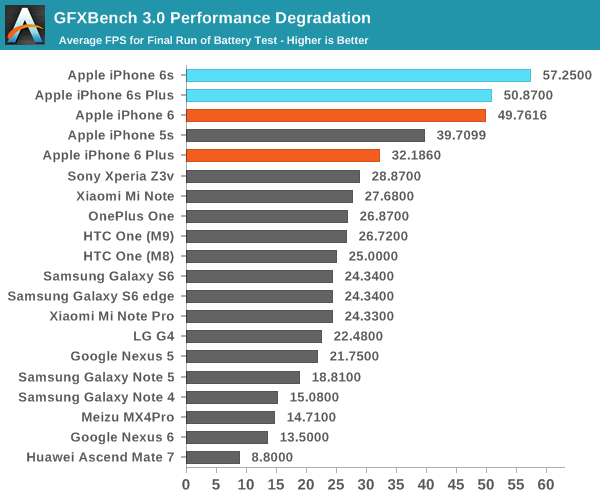
Looking at GFXBench, which is an infinite loop of the T-Rex on-screen benchmark to approximate intensive video gaming we see that the iPhone 6s doesn’t last very long either, but the performance throughout the test is incredible. Due to 1334x750 display resolution and strong GPU, the iPhone 6s manages to last the entire test without any notable throttling, and effectively pegged at the refresh rate of the display. The iPhone 6s Plus manages a similar level of performance but over time you can start to see some throttling, likely a function of the longer runtime and higher display resolution. It’s interesting to see how in the space of two years just how much progress has been made here in terms of improving GPU performance and efficiency, as when we first ran this test it was probably one of the most stressful tests out there for any smartphone or tablet.
Charge Time
Of course, while battery life is usually the main determinant of overall mobility it’s often important to consider charge time. A phone that charges slowly can be much less mobile than another phone, even if it has better battery life. In the case of the iPhone 6s’, it seems that Apple continues to ship the standard 5W charger that they have for many generations in the smartphone industry. In order to see how this charger and phone combination performs, we use our usual methods of timing the phone from fully discharged to fully charged.
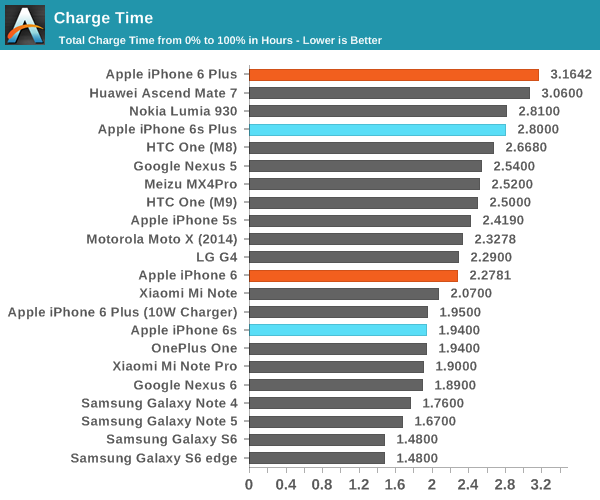
Here, the iPhone 6s and 6s Plus both show a decent improvement over the iPhone 6 and 6 Plus, but not enough to make an significant difference. The iPhone 6s charges at a pretty reasonable rate, but the iPhone 6s Plus really does need a more powerful charger than it does now. You can use an iPad charger to bring things back up to speed but getting this means that you either have to have an iPad already or you have to go out and buy an iPad charger, which is on the annoying side when Android OEMs generally include fast chargers in the box.




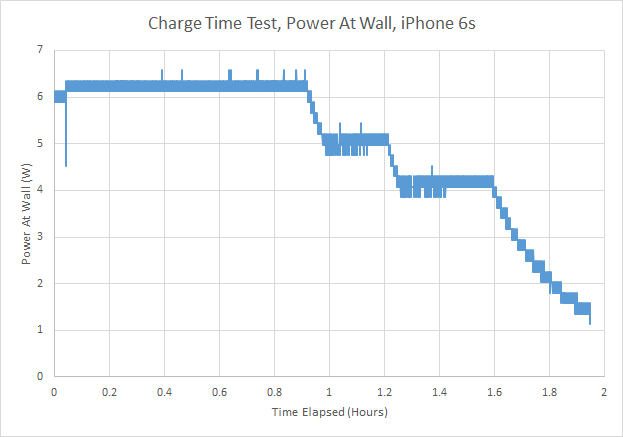
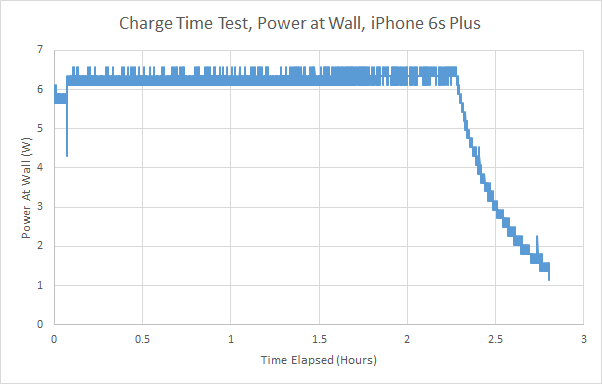








531 Comments
View All Comments
flyingfiddle - Wednesday, November 4, 2015 - link
Truly amazed and convinced that Apple has the best SoC of any phones, and their investment on the SoC paid off. So does their investment on refined iOS experience. I am Android guy but I have to admit I really wish SoC on Android could catch up one day, sooner the better.On the other hand, just because Apple is great in some areas does not mean they should get away with other things that's not as great. The raw power of a high end phone has become more than sufficient for many general users, such that making it more powerful is starting to generate diminished return. I could think of many things that I wish iPhone has, such as longer battery life (i know it's great, relatively, but why not push the boundary?), better screen/body ratio, external memory, more setting and better UI in the camera app, etc.
Well, still not my cup of tea but truly wish Android SoC could catch up one day. That's assuming Android platform survive that long (they have the largest market share but really don't make much money). I hope my money helps supporting them a bit longer..
tytung - Wednesday, November 4, 2015 - link
Can anyone comment on the iPhone 6s Plus frame rate dropping issue ? Animations looks choppy and the frame rate looks like only about 30 fps, unlike 60 fps on the 6s. If the GPU on the phone is so powerful this should not be an issue. In fact, for a phone this expensive UI frame rate drop is really a shameful problem.polmes - Thursday, November 5, 2015 - link
Got tired of iOS and moved to Android (Galaxy S6) earlier this year, but Apple definitely deserves an applause for being basically the only one to keep innovating in the mobile space. kudosSocius - Thursday, November 5, 2015 - link
Hmmmm...any idea why your iPhone 6s Plus scored just 15800 in Google octane when mine scored over 18,000? That's a pretty big discrepancy at 15%. Does your phone have a Samsung CPU? Mine is TSMC.zeeBomb - Thursday, November 5, 2015 - link
Both units are TSMC.Socius - Thursday, November 5, 2015 - link
Then there's something off as there is no way the 6s plus should be scoring just 15,800 on octane.mortimerr - Thursday, November 5, 2015 - link
I've never actually owned an Apple product in my life. All the way back to the original iPod classic. But I will probably finally be changing my stupid principle of 'No Apple Products'.The Android landscape recently has been going back instead of forward. Android 5-6 showcase minor improvements over 4.4.4 (Personally I also prefer Halo. Marshmallow and Lollipop looks slightly cartoony), battery life isn't that much of a leap (a lot of devices are experiencing the mobile radio active bug), and due to the fact that the high end market in the East is so saturated, most OEMs are cutting costs and putting out mid tier phones that lack top end hardware.
A lot of recent releases for Android have a great price point but either have a terrible camera (sensor, pixel size, post processing etc) or the IPS display leaves something to be desired, or it's this or it's that. The only OEM pushing the platform forward is Samsung. But, to be quite frank, I find those devices ugly to look at in every way from the bezel, UI skin, back, front, etc.
Where as Apple continues to simply improve with every iteration. Dual source fab at 14nm! What? 3D touch, increasing the ppi, maintaining solid battery life, great low light camera performance. Offering a big size and a small size with the same internals.
Sony also did this but I don't see the 810 as a very good chip going forward. Especially when it's already pretty far behind in performance to the Exynos and A#. I'll look forward to see if Sony updates the Z line.
I want to wait for Q2'16 for when devices with the 820 start being released, but what's the point when every device will inevitably have some drawback or large flaw or straight up just not be released in N. America.
JTRCK - Friday, November 6, 2015 - link
Where do you want phones to go? There's not much else they can do. A phone being imperfect is "always" the case. There is always something lacking in all these devices, including the iPhone 6S and 6S Plus. One of the first mentions in this review is that the author is still using an HTC One M7 from years ago. Because quite honestly, that was the pinnacle of smartphone design plus an excellent combination of fluid software, excellent performance, and an excellent night performance for a camera (though everything else about that camera was a downgrade). That 3 year old phone is still a very good performer today.Increasing processor/RAM/Storage speed is all excellent and it's expected, but the benefits from such increases are hardly felt by the user on day to day usage. Especially if the software is done properly. Example: I have an old iPhone 4s at home that I use for music streaming that consistently beat out my previous note 4 on application opening, multitasking, sound output quality, web surfing speed, etc. Which phone is superior? Which phone is better? Did AnandTech give that iPhone 4s the BEST award? In my view Apple has always been the king of software and hardware performance. They can get a device with 512mb of ram to outperform a Note 4 with a multicore processor and with 3GB of ram. They should always get the BEST award. But is the BEST (100%) really worth $1,200.00 when the second BEST (99%) is half the price?
I'm not talking about Samsung here. Their phones are expensive with crappy performance. I'm talking about the Moto X Pure, HTC One M9/10, Nexus 6P, etc. I used an iPhone 6S Plus for 2 weeks (and an iPhone 6 Plus for 4 months before that) and returned it for the Nexus 6P. I find the 6P to be a much better phone than the iPhone 6S plus in almost every aspect. It charges faster, it opens applications just as fast, I can multitask faster with the 6P with a side launcher without ever having to see a home screen. I can transition within an app at a faster pace due to dedicated back buttons. A simple thing as not having a "button" to go back a task annoyed me to no end with the iPhone. Not to mention all the limitations of iOS. The only benefit of iPhone for me were the integrations with my Macbook, but other than that. I disliked both iPhones.
The iPhone has all this amazing technology at its core, but my grandmother would never know when using her new 6S. And that's how it should be. I'm more amazed that a Nexus 6P costs half what an iPhone costs while still managing to do just as much, if not more. I honestly found nothing revolutionary about the 6S Plus while using it. In fact, I found it to be quite similar to the 6 Plus. Which I found to be quite similar to the iPhone 4s. Just much larger. And in terms of OS performance, vanilla android at this point is quite simply just as visually pleasing, power efficient, responsive and performant as iOS.
FL777 - Friday, November 6, 2015 - link
Amusingly, there is a YouTube real world speed test between the Nexus 6P and the iPhone 6S and the Nexus 6P BEATS THE IPHONE 6S!!!!!http://www.frequency.com/video/nexus-6p-vs-iphone-...
So much for the iPhone 6S SoC being unbeatable LOL.
Blark64 - Friday, November 6, 2015 - link
Umm, did you watch the video? The difference was milliseconds, and with a "hand-done" test like this the phones were well within the margin of error, and essentially tied. Also, that was possibly the least informative benchmark I've ever seen, since repeatedly launching apps in a tight cycle is something that essentially no one actually does in the real world. That's why benchmarks that are either: more reflective of the real world, or synthetic and scientifically repeatable (like Geekbench and the various browser benchmarks), are probably a better guide.